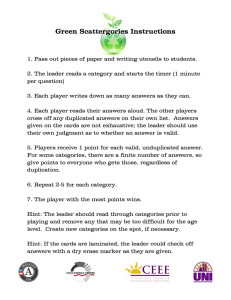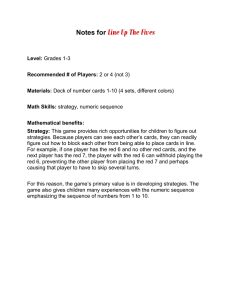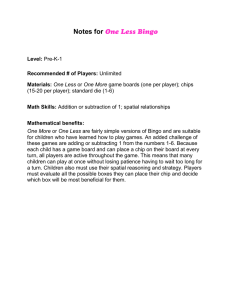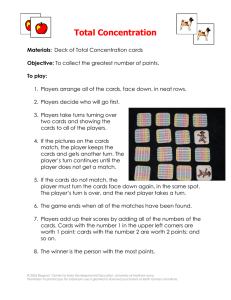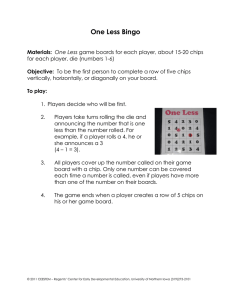Results How would you Spread the Blame?
advertisement
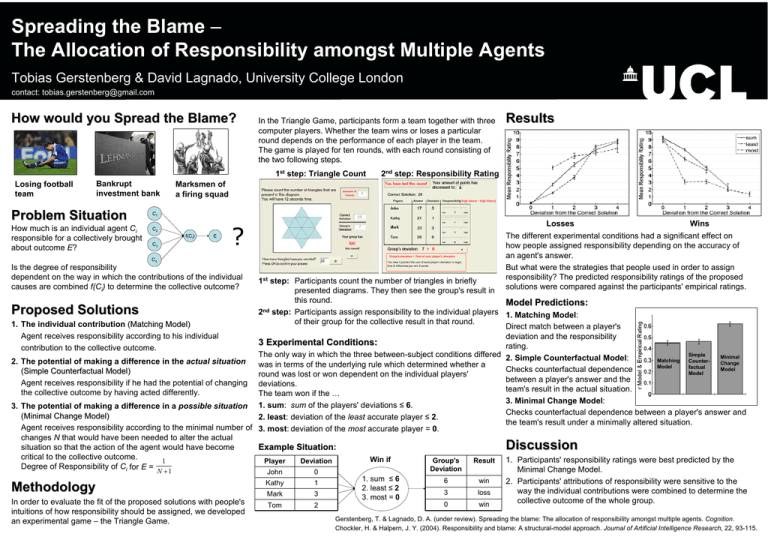
Spreading the Blame – The Allocation of Responsibility amongst Multiple Agents Tobias Gerstenberg & David Lagnado, University College London contact: tobias.gerstenberg@gmail.com How would you Spread the Blame? In the Triangle Game, participants form a team together with three computer players. Whether the team wins or loses a particular round depends on the performance of each player in the team. The game is played for ten rounds, with each round consisting of the two following steps. 1st step: Triangle Count Losing football team Bankrupt investment bank Problem Situation How much is an individual agent Ci responsible for a collectively brought about outcome E? Results 2nd step: Responsibility Rating Marksmen of a firing squad C1 C2 f(Ci) C3 E Losses ? Wins The different experimental conditions had a significant effect on how people assigned responsibility depending on the accuracy of an agent's answer. But what were the strategies that people used in order to assign responsibility? The predicted responsibility ratings of the proposed solutions were compared against the participants' empirical ratings. C4 Is the degree of responsibility dependent on the way in which the contributions of the individual causes are combined f(Ci) to determine the collective outcome? 1st step: Participants count the number of triangles in briefly presented diagrams. They then see the group's result in this round. Model Predictions: 2nd step: Participants assign responsibility to the individual players 1. Matching Model: of their group for the collective result in that round. 1. The individual contribution (Matching Model) Direct match between a player's Agent receives responsibility according to his individual deviation and the responsibility 3 Experimental Conditions: rating. contribution to the collective outcome. Simple The only way in which the three between-subject conditions differed 2. Simple Counterfactual Model: Minimal Matching Counter2. The potential of making a difference in the actual situation Change was in terms of the underlying rule which determined whether a Model factual Model Checks counterfactual dependence (Simple Counterfactual Model) Model round was lost or won dependent on the individual players' between a player's answer and the Agent receives responsibility if he had the potential of changing deviations. team's result in the actual situation. the collective outcome by having acted differently. The team won if the … 3. Minimal Change Model: 3. The potential of making a difference in a possible situation 1. sum: sum of the players' deviations ≤ 6. Checks counterfactual dependence between a player's answer and (Minimal Change Model) 2. least: deviation of the least accurate player ≤ 2. the team's result under a minimally altered situation. Agent receives responsibility according to the minimal number of 3. most: deviation of the most accurate player = 0. changes N that would have been needed to alter the actual situation so that the action of the agent would have become Example Situation: Situation critical to the collective outcome. Win if 1. Participants' responsibility ratings were best predicted by the Group's Result Player Deviation 1 Degree of Responsibility of Ci for E = Deviation Minimal Change Model. Proposed Solutions Discussion N +1 Methodology In order to evaluate the fit of the proposed solutions with people's intuitions of how responsibility should be assigned, we developed an experimental game – the Triangle Game. John 0 Kathy 1 Mark 3 Tom 2 1. sum ≤ 6 2. least ≤ 2 3. most = 0 6 win 3 loss 0 win 2. Participants' attributions of responsibility were sensitive to the way the individual contributions were combined to determine the collective outcome of the whole group. Gerstenberg, T. & Lagnado, D. A. (under review). Spreading the blame: The allocation of responsibility amongst multiple agents. Cognition. Chockler, H. & Halpern, J. Y. (2004). Responsibility and blame: A structural-model approach. Journal of Artificial Intelligence Research, 22, 93-115.
